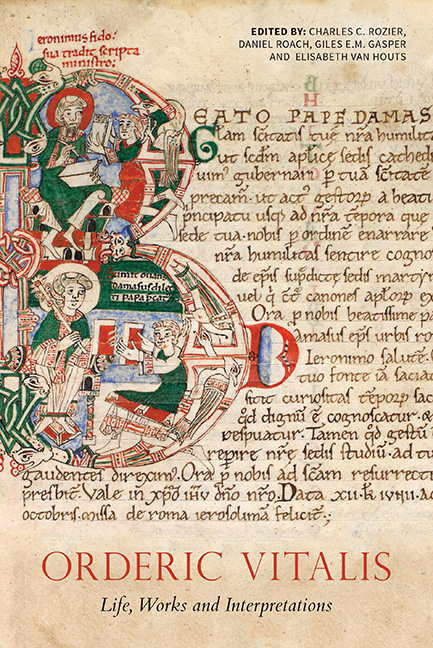Book contents
- Frontmatter
- Dedication
- Contents
- List of Illustrations
- Acknowledgements
- List of Abbreviations
- Chronology of the Lives of Odelerius and his Son Orderic Vitalis
- Composition of the Historia ecclesiastica
- Introduction: Interpreting Orderic Vitalis
- Orderic and his Father, Odelerius
- Following the Master's Lead: The Script of Orderic Vitalis and the Discovery of a New Manuscript (Rouen, BM, 540)
- Orderic Vitalis as Librarian and Cantor of Saint-Évroul
- Saint-Évroul and Southern Italy in Orderic's Historia ecclesiastica
- Orderic and English
- Inscriptions in Orderic's Historia ecclesiastica: A Writing Technique between History and Poetry
- Reading Orderic with Charters in Mind
- Orderic Vitalis and the Cult of Saints
- Orderic's Secular Rulers and Representations of Personality and Power in the Historia ecclesiastica
- Worldly Woe and Heavenly Joy: The Tone of the Historia ecclesiastica
- Orderic Vitalis, Historical Writing and a Theology of Reckoning
- Jesus Christ, a Protagonist of Anglo-Norman History? History and Theology in Orderic Vitalis's Historia ecclesiastica
- ‘Studiosi abdita investigant’: Orderic Vitalis and the Mystical Morals of History
- Meanders, Loops, and Dead Ends: Literary Form and the Common Life in Orderic's Historia ecclesiastica
- Orderic and the Tironensians
- ‘One single letter remained in excess of all his sins …’: Orderic Vitalis and Cultural Memory
- The Reception of Orderic Vitalis in the Later Middle Ages
- Appendix 1 Archaeological Investigations at the Abbey of Saint-Évroult-Notre-Dame-des-Bois
- Appendix 2 Descriptive Catalogue of Manuscripts Featuring the Hand of Orderic Vitalis
- Select Bibliography
- List of Manuscripts Cited
- General Index
Saint-Évroul and Southern Italy in Orderic's Historia ecclesiastica
Published online by Cambridge University Press: 25 October 2017
- Frontmatter
- Dedication
- Contents
- List of Illustrations
- Acknowledgements
- List of Abbreviations
- Chronology of the Lives of Odelerius and his Son Orderic Vitalis
- Composition of the Historia ecclesiastica
- Introduction: Interpreting Orderic Vitalis
- Orderic and his Father, Odelerius
- Following the Master's Lead: The Script of Orderic Vitalis and the Discovery of a New Manuscript (Rouen, BM, 540)
- Orderic Vitalis as Librarian and Cantor of Saint-Évroul
- Saint-Évroul and Southern Italy in Orderic's Historia ecclesiastica
- Orderic and English
- Inscriptions in Orderic's Historia ecclesiastica: A Writing Technique between History and Poetry
- Reading Orderic with Charters in Mind
- Orderic Vitalis and the Cult of Saints
- Orderic's Secular Rulers and Representations of Personality and Power in the Historia ecclesiastica
- Worldly Woe and Heavenly Joy: The Tone of the Historia ecclesiastica
- Orderic Vitalis, Historical Writing and a Theology of Reckoning
- Jesus Christ, a Protagonist of Anglo-Norman History? History and Theology in Orderic Vitalis's Historia ecclesiastica
- ‘Studiosi abdita investigant’: Orderic Vitalis and the Mystical Morals of History
- Meanders, Loops, and Dead Ends: Literary Form and the Common Life in Orderic's Historia ecclesiastica
- Orderic and the Tironensians
- ‘One single letter remained in excess of all his sins …’: Orderic Vitalis and Cultural Memory
- The Reception of Orderic Vitalis in the Later Middle Ages
- Appendix 1 Archaeological Investigations at the Abbey of Saint-Évroult-Notre-Dame-des-Bois
- Appendix 2 Descriptive Catalogue of Manuscripts Featuring the Hand of Orderic Vitalis
- Select Bibliography
- List of Manuscripts Cited
- General Index
Summary
This chapter explores the ties that bound the abbey and monks of Saint-Évroul with the peninsula of southern Italy, focusing on the ways in which Orderic repeatedly linked the two regions in Books III to VII of his Historia ecclesiastica. Beginning in Book III of the Historia, the material on southern Italy constitutes the first major outward movement of the narrative beyond the borders of the Normandy. The discussion that follows considers why and how Orderic wrote about this region. It suggests that the close links between Saint-Évroul and southern Italy were established and maintained by the movement of many monks, patrons and founders of the monastery to and from the peninsula, and of various relics and other physical objects that came into the possession of the extended network of houses associated with Saint-Évroul, both in southern Italy and in Normandy. These movements of people and material, and the memorial culture in which they were understood, encouraged Orderic to narrate the activity of Norman families and church men in southern Italy and enabled him to do so in such a way as to link this material to the remainder of the work. While the works of authors such as William of Apulia, Geoffrey Malaterra and Amatus of Montecassino can be used to corroborate and occasionally enhance our understanding of individuals related to Saint-Évroul, it appears that these medieval chroniclers were unaware of the majority of these links. Only in Orderic's Historia are such connections stressed.
Orderic had already written on events in southern Italy while copying and expanding William of Jumièges’ Gesta Normannorum ducum, between c. 1109 and c. 1113. There Orderic chronicled the exile of Robert of Grandmesnil, one of the co-founders of Saint-Évroul and also its second abbot, and the foundation of the abbey of St Euphemia in Calabria. Such episodes meant that the story of Saint-Évroul overlapped with that of the Norman conquest of southern Italy by Robert Guiscard and his brothers in the second half of the eleventh century. Each of these episodes was later used by Orderic in Book III of the Historia, along with other information not found in the Gesta Normannorum ducum.
- Type
- Chapter
- Information
- Orderic Vitalis: Life, Works and Interpretations , pp. 78 - 99Publisher: Boydell & BrewerPrint publication year: 2016

